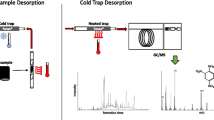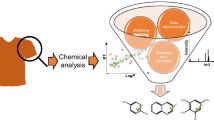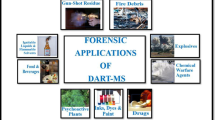Abstract
Residues of chemicals on clothing products were examined by direct analysis in real-time (DART) mass spectrometry. Our experiments have revealed the presence of more than 40 chemicals in 15 different clothing items. The identification was confirmed by DART tandem mass spectrometry (MS/MS) experiments for 14 compounds. The most commonly detected hazardous substances were nonylphenol ethoxylates (NPEs), phthalic acid esters (phthalates), amines released by azo dyes, and quinoline derivates. DART-MS was able to detect NPEs on the skin of the person wearing the clothing item contaminated by NPE residuals. Automated data acquisition and processing method was developed and tested for the recognition of NPE residues thereby reducing the analysis time.




Similar content being viewed by others
References
Regulation (EC) no. 1907/2006 of the European Parliament and of the Council. Off J Eur Union. 2006; L396.
Brigden K, Hetherington S, Wang M, Santillo D, Johnston P. Hazardous chemicals in branded luxury textile products on sale during 2013. Greenpeace Research Laboratories Technical Report 01, 2014. http://www.greenpeace.org/international/Global/international/publications/toxics/2014/Technical-Report-01-2014.pdf Accessed 29 Jan 2016.
Swedish Chemicals Agency. Chemicals in textiles—risks to human health and the environment report from a government assignment. Stockholm: Swedish Chemicals Agency. Arkitektkopia; 2014.
Cioni F, Bartolucci G, Pieraccini G, Meloni S, Moneti G. Development of a solid phase microextraction method for detection of the use of banned azo dyes in coloured textiles and leather. Rapid Commun Mass Spectrom. 1999;13:1833–7.
Luongo G, Thorsén G, Östman C. Quinolines in clothing textiles—a source of human exposure and wastewater pollution? Anal Bioanal Chem. 2014;406:2747–56.
Zhang SX, Chai XS, Huang BX, Mai XX. A robust method for determining water-extractable alkylphenol polyethoxylates in textile products by reaction-based headspace gas chromatography. J Chromatogr A. 2015;1406:94–8.
Lv G, Wang L, Liu S, Li S. Determination of perfluorinated compounds in packaging materials and textiles using pressurized liquid extraction with gas chromatography-mass spectrometry. Anal Sci. 2009;25:425–9.
Cody RB, Laramee JA, Durst HD. Versatile new ion source for the analysis of materials in open air under ambient conditions. Anal Chem. 2005;77:2297–302.
Lam P-l, Kan C-w, Yuen MC-w, Cheung S-y, Gambari R, Lam K-h, et al. Studies on quinoline type dyes and their characterisation studies on acrylic fabric. Color Technol. 2012;128:192–8.
Horai H, Arita M, Kanaya S, Nihei Y, Ikeda T, Suwa K, et al. MassBank: a public repository for sharing mass spectral data for life sciences. J Mass Spectrom. 2010;45:703–14.
mzCloud.orgTM, Advanced Mass Spectral Database, HighChem LLC, Slovakia https://www.mzcloud.org/. Accessed 29 Jan 2016.
Mohsin SB, Woodman M. Quantitation of trace level emerging contaminants in water using online SPE with LC/MS/MS. Agilent Technologies Application Note 5991-2731EN, 2013.
Porter DJ. Analysis of oil resins using electrospray ionization mass spectrometry. Thesis submitted to the Faculty of Graduate and Postdoctoral Studies University of Ottawa. Ottawa: National Library of Canada; 2003
Toxicological review of quinoline, EPA/635/R-01/005. Washington: US Environmental Protection Agency; 2001.
Stellman JM, editor. Encyclopaedia of occupational health and safety: guides, indexes, directory. 4th ed. Geneva: International Labour Office; 1998.
Libralato G, Volpi Ghirardini A, Avezzù F. Seawater ecotoxicity of monoethanolamine, diethanolamine and triethanolamine. J Hazard Mater. 2009;176:535–9.
Anastassiades M, Kolberg DI, Eichhorn E, Benkenstein A, Lukačević S, Mack D, et al. Quick method for the analysis of numerous highly polar pesticides in foods of plant origin via LC-MS/MS involving simultaneous extraction with methanol (QuPPe-Method). Stuttgart: EU Reference Laboratory for pesticides requiring Single Residue Methods (EURL-SRM); 2015. http://www.crl-pesticides.eu/library/docs/srm/meth_QuPPe.pdf. Accessed 29 Jan 2016.
European Communities. Directive 2005/84/EC of the European Parliament and of the Council. Off J Eur Union. 2005;L 344:40.
110th United States Congress. Consumer Product Safety Improvement Act (CPSIA). 2008. http://www.cpsc.gov/cpsia.pdf Accessed 29 Jan 2016.
Kuki Á, Nagy L, Zsuga M, Kéki S. Fast identification of phthalic acid esters in poly(vinyl chloride) samples by direct analysis in real time (DART) tandem mass spectrometry. Int J Mass Spectrom. 2011;303:225–8.
TenEyck MC, Markee TP. Toxicity of nonylphenol, nonylphenol monoethoxylate, and nonylphenol diethoxylate and mixtures of these compounds to Pimephales promelas (fathead minnow) and Ceriodaphnia dubia. Arch Environ Contam Toxicol. 2007;53:599–606.
Soares A, Guieysse B, Jefferson B, Cartmell E, Lestera JN. Nonylphenol in the environment: a critical review on occurrence, fate, toxicity and treatment in wastewaters. Environ Int. 2008;34:1033–49.
Loyo-Rosales JE, Rice CP, Torrents A. Octyl and nonylphenol ethoxylates and carboxylates in wastewater and sediments by liquid chromatography/tandem mass spectrometry. Chemosphere. 2007;68:2118–27.
Johnson V, Patel SJ, Shah D, Patel KA, Mehta MH. ε-caprolactam waste liquor degradation by various yeasts. World J Microbiol Biotechnol. 1994;10:524–6.
Monographs on the evaluation of carcinogenic risk to humans. International Agency for Research on Cancer (IARC) http://monographs.iarc.fr/ENG/Classification/latest_classif.php Accessed 29 Jan 2016.
Acknowledgments
This work was financially supported by the grant K-101850 given by OTKA (National Found for Scientific Research Development, Hungary) and the grant TÁMOP-4.2.2.A-11/1/KONV-2012-0036 supported by the European Union and co-funded by the European Social Fund.
Author information
Authors and Affiliations
Corresponding author
Ethics declarations
Conflict of interest
The authors declare that they have no conflict of interest.
Electronic supplementary material
Below is the link to the electronic supplementary material.
ESM 1
(PDF 537 kb)
Rights and permissions
About this article
Cite this article
Antal, B., Kuki, Á., Nagy, L. et al. Rapid detection of hazardous chemicals in textiles by direct analysis in real-time mass spectrometry (DART-MS). Anal Bioanal Chem 408, 5189–5198 (2016). https://doi.org/10.1007/s00216-016-9603-z
Received:
Revised:
Accepted:
Published:
Issue Date:
DOI: https://doi.org/10.1007/s00216-016-9603-z




